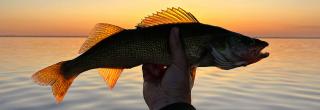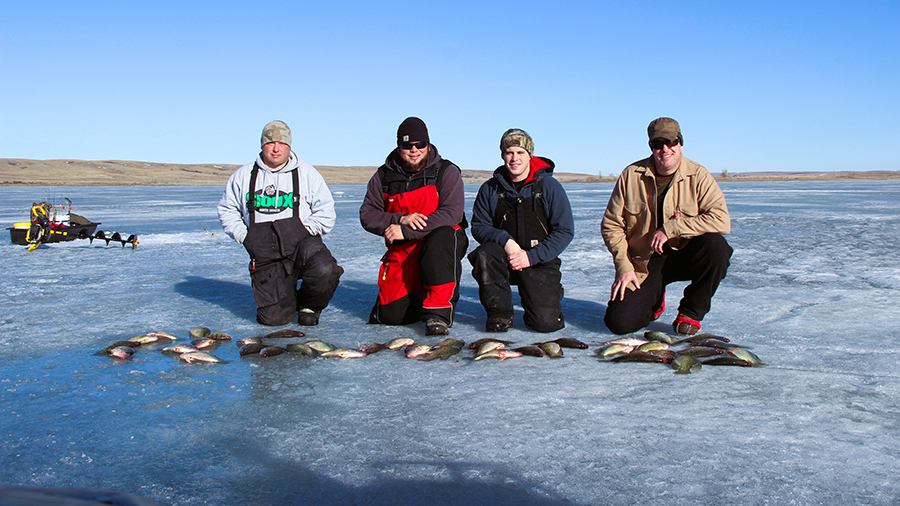
The Best Fishing Ever
By Paul Bailey
I have been fortunate to experience some great fishing close to where I live and work in south central North Dakota. Grainy photos of me in my single-digit years struggling to hoist stringers of plump walleye attest to the terrific walleye fishing in Lake Oahe in the early 1980s. Another remarkable year of fishing occurred on Lake Oahe in 2009 and the fishing in the Garrison Dam Tailrace was nothing short of spectacular in 2012.
I and many other anglers got to experience extraordinary fishing for walleye at places like Alkaline, Jasper, Sibley, Josephine, Crimmins WPA, Geneva, Logan Lake, West Napoleon, Marvin Miller, Logan WMA, Green, Dry, Kislingbury, Harr, Wentz WPA and Rice Lake. I was privileged to participate in the “hot bite” in all these instances where it was common to harvest a limit of walleye in minutes and then proceed with a friendly competition to see how many consecutive casts a fish could be landed and released. My personal record still stands at 18 from Lake Geneva on a fall evening in 2020.
Similar outstanding opportunities have also materialized over the years in many places including Lake Sakakawea salmon and trophy northern pike, Lake Oahe crappie, Devils Lake perch and white bass, Red River channel catfish, Lake Audubon smallmouth bass, Lake Metigoshe bluegill, and Nelson Lake largemouths to name a few.
The bulk of these fisheries continue to maintain high quality angling opportunities despite the most spectacular fishing being somewhat fleeting. So why can’t fishing always be the best it’s ever been? A fair question I’ve fielded numerous times as a fisheries biologist.
Perhaps this question can best be answered by describing the circumstances that led to “the best fishing ever” at several of our waters.
Alkaline Lake Perch
No sport fish in North Dakota may be more prone to boom-and-bust cycles than yellow perch. When environmental conditions are right, they thrive. And when conditions change, they just as quickly fade away. Such is the history of perch in Alkaline Lake.
Prior to the winter of 1996-97, Alkaline Lake was a large cattail slough complex well known to area waterfowl hunters. As a record amount of snow began to melt in the spring of 1997, these shallow sloughs were transformed into the fifth largest natural lake (by surface area) in North Dakota. A few perch made their way into Alkaline Lake from adjoining Fresh Lake and this proved to be enough.
In its early days, Alkaline Lake offered everything a yellow perch could ever want. Flooded vegetation provided ideal spawning habitat (perch deposit their skeins of eggs on vegetation), a smorgasbord of aquatic invertebrate forage was available, the lake had enough depth to avoid winterkill and remain relatively cool during summer, and perch predators were scarce. Just three years after Alkaline Lake filled, these factors combined to produce some of the most phenomenal perch fishing that many anglers had ever seen.
Even at a time when “going viral” was not yet part of our everyday jargon, word of this extraordinary perch bite spread like wildfire. By some accounts, the gathering of Alkaline Lake ice anglers on a few late winter weekends may have unofficially become one of North Dakota’s 10 largest cities.
In a November 2005 North Dakota OUTDOORS article, Greg Power, current Game and Fish Department fisheries chief, documented the exceptional amount of perch fishing pressure that Alkaline Lake received after anglers discovered this fishery. “In February and March of 2000, before a daily perch limit was put in place, thousands of ice anglers caught tens, if not hundreds of thousands of perch. Not only did the harvested perch fill buckets, but in some cases, people pulled home ice sleds full of perch.”
Just as quickly as the Alkaline perch boom appeared, it passed. The flooded vegetation that provided perfect perch spawning habitat had been digested by invertebrate grazers and recruitment of additional perch into this fishery declined. Just as importantly, the initial surge in lake productivity that immediately followed the formation of Alkaline Lake had dissipated and perch began competing among themselves, and with increasingly abundant fathead minnows, for a dwindling amount of invertebrate forage. A perfect recipe for a perch boom and bust.
Lake Oahe Crappie
North Dakota is situated towards the northern edge of the range of both black and white crappie. Lake Oahe has abundant areas of gravel that nest-building crappie prefer for spawning habitat and a low number of adult crappie can produce lots of offspring. In fact, young-of-the-year crappie are one of the most common forage items for Oahe’s larger predators like walleye and channel catfish each fall. However, our short growing season for these fish means newly hatched crappie are in a race against time to build up enough size and energy reserves to make it through their first winter on the Northern Plains. This is a race they lose more often than not in Oahe.
However, a series of events aligned to produce some extraordinary crappie fishing in the North Dakota portion of Lake Oahe, beginning with the severe drought from 2000 to 2008. During this drought, Lake Oahe ceased to exist in North Dakota as it receded into the historic Missouri River channel. This exposed tens of thousands of acres of river floodplain that quickly became covered in cottonwoods, willows, clover, cattails, phragmites, reed canary grass, and a variety of other types of vegetation that played host to whitetails and roosters.
Marvin Miller Walleye
Mother Nature deserves much of the credit for the Alkaline Lake perch and Lake Oahe crappie examples. Marvin Miller Lake provides an example of how biological manipulation through fisheries management actions can produce some of the “best fishing ever” as well.
Marvin Miller Lake is surrounded by private land. A fishing access easement was secured in 1997 and the Department initially stocked perch. The perch introduction met with limited success due to the lake’s abundant fathead minnows that tend to compete with perch for invertebrate forage. But these fathead minnows are excellent forage for walleye.
The Department first stocked walleye (5,000 fingerlings) in 2002 and fish from this initial stocking survived and grew well. Annual stockings of 14,000 to 18,000 walleye continued from 2003 through 2007 and met with great success. By 2007, Marvin Miller Lake contained an excellent walleye population … with one problem: the fish wouldn’t bite.
Fathead minnows remained extremely abundant, and these well-fed walleyes had no reason to feed on the offerings from anglers. A big part of my job as a fisheries biologist is to provide the best fishing possible for anglers to enjoy and seeing lots of large, uncooperative walleye in Marvin Miller Lake during our netting surveys became a professional frustration.
Like many of our prairie lakes, Marvin Miller has high salinity levels that prevent successful natural reproduction of walleye. Given the absence of natural reproduction, a logical solution was to increase the walleye stocking rate to reduce the numbers of fathead minnows through increased predation so the walleye would eventually have less to eat and be more apt to bite an angler’s offering.
The logic was sound, but the desired results proved elusive.
In 2008 and 2009, we increased the stocking rate to approximately 26,000 walleye fingerlings annually. The result: more and bigger walleye that still didn’t bite.
In 2010 and 2011, we increased the stocking rate to approximately 50,000 walleye fingerlings annually. The result: even more and bigger walleye that still didn’t bite. We now had a lake with an extraordinary number of walleyes, many of which were over 25 inches that simply wouldn’t bite. A bit exasperated, we increased the stocking rate to nearly 100,000 fish in 2012, a rate (fish per acre) I have not stocked at before or since.
That did it.
Sampling in fall of 2012 revealed that the fathead minnow forage base had crashed due to walleye predation and these fish should be ready to cooperate with anglers.
In what proved to be impeccable timing, the private landowner agreed to a longer-term fishing access easement and allowed a public boat ramp to be installed on his property in the fall of 2012.
Winter of 2012-13 was brutally cold, likely keeping many ice anglers from venturing out but the fishing at Marvin Miller Lake that greeted anglers in spring of 2013 was undoubtedly the best many had ever experienced. Catching a five-walleye harvest limit in five consecutive casts, whether from shore or boat, was a common experience. Whatever techniques anglers threw at these fish seemed to work. Bouncing a jig, slip bobbers, soaking a lindy rig, casting crank baits, or pulling spinners and bottom bouncers. It was as if a decade of anticipation had finally come to fruition and, for a few months in 2013, Marvin Miller Lake offered some of the best walleye fishing our state has ever seen.
While the fishing was spectacular, there was a price to pay for crashing the forage base. Anglers harvested a tremendous number of walleyes from Marvin Miller in 2013, but the fathead minnow population was slow to respond to this reduction in predators. This led to declining walleye numbers and, what walleye remained were in poor condition and exhibited slow growth. The fishing went from extraordinary to sub-par in a hurry.
We reduced stocking rates back down to approximately 25,000 walleye annually and have since achieved a more desirable balance between predators and prey. This has resulted in Marvin Miller Lake providing consistently good walleye fishing in recent years but nothing like the spring of 2013.
What's to Come?
If history is any indicator, more extraordinary angling opportunities are bound to occur. The environmental extremes we experience in North Dakota, from droughts to floods, from heat waves to Alberta clippers, blizzards and derechos, will continue to shape our landscape and produce more of “the best fishing ever.” I hope to be there when it happens.

